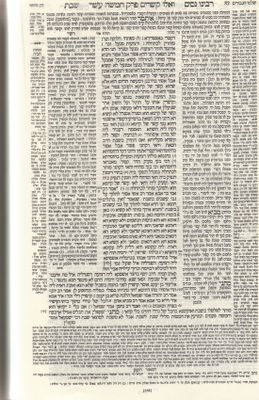
HIDE/SHOW IMAGE
41b
{Shabbat 112a}
"THE OPENING OF HER CHEMISE etc.:
This is permitted even initially {lechatchila}.
"AND THE LACES OF HER SHOES OR SANDALS":
It was stated:
If one unties the laces of his shoes or sandals, — one [Baraitha] taught: He is liable to a sin-offering; another taught: He is not liable, yet it is forbidden; while a third taught: It is permitted in the first place.
Thus [the rulings on] shoes are contradictory, and [those on] sandals are contradictory?
[The rulings on] shoes are not contradictory: when it teaches, 'he is liable to a sin-offering', it refers to cobblers' [knots] - and this is a permanent knot; 'he is not liable, but it is forbidden' — that refers to [a knot] of the Rabbis - which is the act of a non-expert, but it is a permanent knot, and therefore he is not liable but it is forbidden; 'it is permitted in the first place', refers to [the knots] of the townspeople of Machoza - such as the straps that come out from the body of the shoes and they tie it on the leg and on the thigh after they tie the shoe, such that it is not the work of a craftsman, and is not a permanent knot.
[The rulings on] sandals too are not contradictory: when it states that 'one is liable to a sin-offering', it refers to [sandals] of travellers tied by cobblers - which is also a permanent knot - such as that which they call nowadays tasma, which they make according to the measure of the ankle of the leg, and they tie it an exemplary knot, and if one unties it on Shabbat, his is liable to a sin-offering. And this that it states 'one is not liable yet it is forbidden' refers to chumrata {= lit. balls} tied by [the wearers] themselves;
And how so these chumrata? They gather all of the straps and raise them up in a ball, such that if they wish to tighten it, they once again tie from outside it, and if they want they may loosen it.
And this that it states 'it is permitted at the outset' refers to sandals in which two go out wearing it, for there are times that the one goes out, and loosens it, and there are times that the other one goes out, and tightens it - and this is not a permanent knot, and therefore it is permitted even initially.
{Eruvin 100b}
Rav Ammi bar Abba cited Rav Ashi: It is forbidden to walk on asavim {grass, herbs} on Shabbat, for it states (Mishlei 19:1):
| ב גַּם בְּלֹא-דַעַת נֶפֶשׁ לֹא-טוֹב; וְאָץ בְּרַגְלַיִם חוֹטֵא. | 2 Also, that the soul be without knowledge is not good; and he that hasteth with his feet sinneth. |
This is no question. Here is in the sunny season, here is in the rainy season.
And if you want I will say: this and that are in the rainy season, but here is where they have long blades {switching resh for daled}, and here is where they do not have long blades.
And if you want I will say: this and that are where they have long stems, but here is where he is wearing his shoes, and here is where he is not wearing his shoes.
And if you want I will say: this and that are where he is wearing his shoes, and it is no question. Here is when it {his shoe} has spurs {nails on the bottom} and here is where it does not have spurs.
And now {that we rule like Rabbi Shimon that something done without intent is allowed} all are permitted.
{Shabbat 112a resumes}
Rabbi Yirmiya was walking behind Rabbi Abahu in a karmelit, when the lace of his sandal snapped.
{He {Rabbi Yirmiya} said: What shall I do with it?}
He said to him: Take a moist reed that is fit for an animal's food and wind it about it.
Abaye was standing before Rav Yosef in a chatzer {=courtyard}, when the lace of his sandal snapped.
He {Abaye} said: What shall I do with it?
He said to him: Leave it.
And how is this different than the case of Rabbi Yirmiya?
There {in the karmelit} it was not guarded {and others might take it}; here it is guarded.
{Shabbat 112b}
"R. ELIEZER B. JACOB SAID: ONE MAY TIE [A ROPE] IN FRONT OF AN ANIMAL,THAT IT SHOULD NOT GO OUT":
And even though where there are two cords.
{Shabbat 113a}
I would have said that he [the owner] may completely disregard one {he will untie only the lower one, and the animal can leave the stable by stooping.}; hence he [the Tanna] informs us (that we do not fear this).
Rav Yosef cited Rav Yehuda who cited Shmuel: the halacha is as Rabbi Eliezer ben Yaakov.
"A BUCKET [OVER A WELL] MAY BE TIED...":
Rabbi Abba cited Rabbi Chiyya bar Abba {our gemara: bar Ashi} who cited Rav: A man may bring a weaver's rope from his house and tie it to a cow and [its] trough.
And Rav Nachman cited Shmuel: If it is a weaver's implements, it is permissible to handle it on Shabbat, and we establish that as speaking of a weaver's rope, which is a weaver's implement.
MISHNA:
ONE MAY FOLD UP GARMENTS EVEN FOUR OR FIVE TIMES, AND SPREAD THE SHEETS ON THE BEDS ON THE NIGHT OF SHABBAT FOR [USE ON] SHABBAT, BUT NOT ON THE SHABBAT FOR [USE ON] THE CONCLUSION OF SHABBAT.



No comments:
Post a Comment